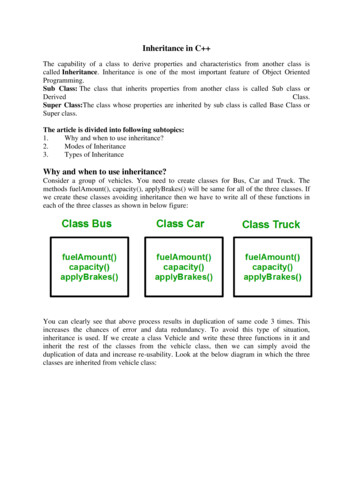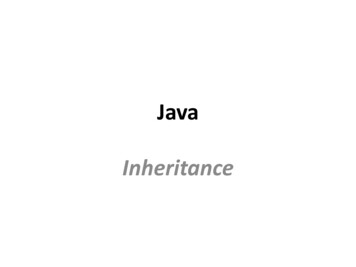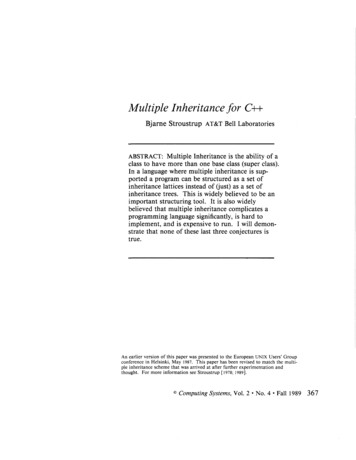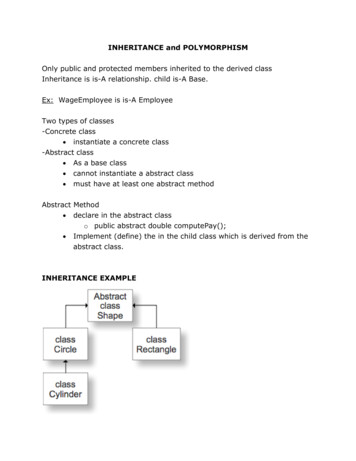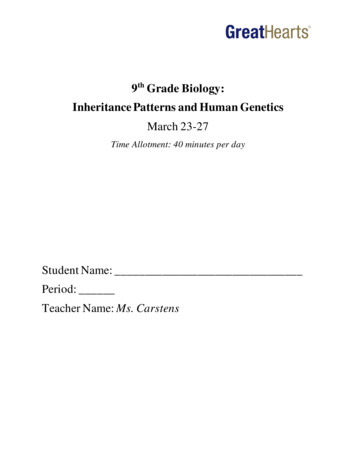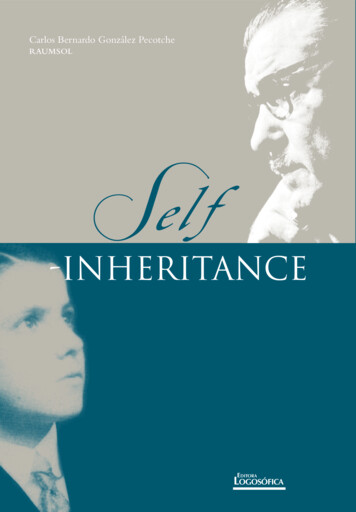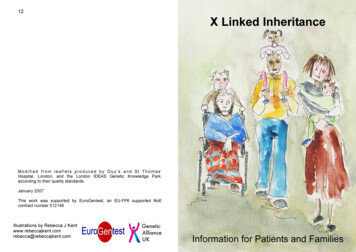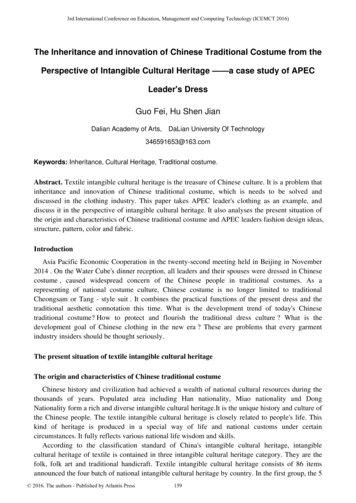
Transcription
3rd International Conference on Education, Management and Computing Technology (ICEMCT 2016)The Inheritance and innovation of Chinese Traditional Costume from thePerspective of Intangible Cultural Heritage ——a case study of APECLeader's DressGuo Fei, Hu Shen JianDalian Academy of Arts,DaLian University Of Technology346591653@163.comKeywords: Inheritance, Cultural Heritage, Traditional costume.Abstract. Textile intangible cultural heritage is the treasure of Chinese culture. It is a problem thatinheritance and innovation of Chinese traditional costume, which is needs to be solved anddiscussed in the clothing industry. This paper takes APEC leader's clothing as an example, anddiscuss it in the perspective of intangible cultural heritage. It also analyses the present situation ofthe origin and characteristics of Chinese traditional costume and APEC leaders fashion design ideas,structure, pattern, color and fabric.IntroductionAsia Pacific Economic Cooperation in the twenty-second meeting held in Beijing in November2014 . On the Water Cube's dinner reception, all leaders and their spouses were dressed in Chinesecostume , caused widespread concern of the Chinese people in traditional costumes. As arepresenting of national costume culture, Chinese costume is no longer limited to traditionalCheongsam or Tang - style suit . It combines the practical functions of the present dress and thetraditional aesthetic connotation this time. What is the development trend of today's Chinesetraditional costume? How to protect and flourish the traditional dress culture ? What is thedevelopment goal of Chinese clothing in the new era ? These are problems that every garmentindustry insiders should be thought seriously.The present situation of textile intangible cultural heritageThe origin and characteristics of Chinese traditional costumeChinese history and civilization had achieved a wealth of national cultural resources during thethousands of years. Populated area including Han nationality, Miao nationality and DongNationality form a rich and diverse intangible cultural heritage.It is the unique history and culture ofthe Chinese people. The textile intangible cultural heritage is closely related to people's life. Thiskind of heritage is produced in a special way of life and national customs under certaincircumstances. It fully reflects various national life wisdom and skills.According to the classification standard of China's intangible cultural heritage, intangiblecultural heritage of textile is contained in three intangible cultural heritage category. They are thefolk, folk art and traditional handicraft. Textile intangible cultural heritage consists of 86 itemsannounced the four batch of national intangible cultural heritage by country. In the first group, the 5 2016. The authors - Published by Atlantis Press159
items are included in the Miao dress, the Hui nationality costume; the 10 items of folk art areincluded in the Gu embroidery, the Su embroidery, the Xiang embroidery; the 16 items oftraditional handicrafts are included in Nanjing brocade wood machine makeup flower hand weavingskills, Song brocade weaving skills. In the second group, the 11 items of folk custom are Includedin Mongolia nationality costume and She nationality costume; the 13 items of folk art are includedin Dui brocade and Huang Zhong Dui embroidery; the 14 items of Traditional craftsmanship areincluded in silk weaving techniques and traditional cotton textile technology. In the third group,only 1 items of folk custom is included in the Tajik nationality costume; the 6 items of folk art areincluded in Shanghai woolen embroidery and Ningbo cannetille embroidery; the 2 items oftraditional technology are included in Blue Jiaxie skills and Chinese costume making skill. In thefourth group, the 6 items of folk custom are included in the Ewenki nationality costume and Yinationality costume; the 2 items of folk art are included in Beijing embroidery and drawn work. Itconcludes that most folk intangible cultural heritage for the cultural space in the ethnic costumes .Folk art mainly contains all kinds of embroidery skills . Traditional crafts mainly contains weavingand printing and dyeing skills.The definition of Chinese costume is the characteristic of Chinese traditional costume or thecharacteristic of Chinese ethnic costume. It also was well-known as the "china costume",or"national costume". It represents a Chinese national identity and national identity or belonging tothe identification of clothing. It is an important part of the national culture displaying somesymbolic value and cultural meaning of social attribute.China ancient costume background is the patriarchal culture includingConfucianism .Taoist thought and the feudal ethics. The nature of " social class" in Chinese ancientclothing was created at the beginning. “Yellow Emperor, Yao Emperor and Shun Emperorconquered the world after showing their costume down.”Zhou Yi said. Costume hierarchic ranksystem defined by ruling class at the beginning of Xia Dynasty and Shang Dynasty. It matures inZhou Dynasty. The ancient Chinese costume system ignored the human body, and suppressed thepersonality of the people. Ruling class trying to consolidate their dominance.Chinese clothing culture is relatively independent conservative and pay attention to theeffect of plane decoration. Chinese culture originates from the Yellow River civilization. TheChinese nation live and work in peace. They cultivated, planted and made sericulture. The UnitedNations and highly developed cultural system in the formation of multi ethnic groups in chinabecause the geographical environment is relatively closed and long feudal rule. Chinese ancientclothing express cultural characteristics mentioned above in the form of a plane. The mostprominent feature is the comprehensive innovation of painting art and embroidery pattern, and givesthe design to the symbolic meaning.China pursues cover and parcel dress Philosophy. China pursues the dress culture of thelenient clothes which cover people's whole body but in Tang Dynasty. A woman can show her chestin Tang Dynasty. Around tenth Century, people misunderstanding aesthetic standards by parcel.The parents forced their daughter Foot - binding for their future. They paid the price of blood andtears for meeting their aesthetic standard even compressed with slate and beaten by sticks. However,the feet are never exposed.The inheritance and innovation of Chinese traditional costumeA wide variety of Chinese traditional costume clothing has experienced thousands of years.What is the starting point of our traditional costume design in China today? Is it based on thecharacteristics of the costumes of a certain dynasty or the clothing of a certain ethnic groups? It160
Should mastery in different periods and different ethnic Chinese traditional costumes instead ofadhering to the costumes of a certain nation in a certain historical period. It is necessary to explorethe cultural gene of Chinese costume in thousands of years of Chinese traditional culture system.More important and more difficult is to change the culture of these genes then recombine With themethod of modern innovation. The goal is not only to show the Chinese traditional aesthetic spirit,but also to make it adapt to the contemporary Chinese people's aesthetic and dress style. All thedesigners are thinking about the same problem, how to inherit and how to innovate?The overall design concept. Aesthetic value is a core component of traditional Chinese costume.It pursues the spiritual ideal higher than the existence For thousands of years, the form of Chineseclothing is changed according to the Chinese culture spirit behind of the surface form. Fashiondesign and decorative patterns are only the form of traditional clothing which including Caftan, RuCostume, Pan Kou and Unlined Clothes. China cultural spirit is graceful and arrogant. This"inherited tradition" is a terrible thing if we just simply imitated the style of traditional costumes orno longer understand this both open, firm and indomitable ideal. So we need to go back to the rootof Chinese traditional culture then mining, arrangement and innovative design . A designer whoneed to understand how to use our traditional weaving process, dyeing process, sewing process andpattern of meaning especially in the clothing culture. On the basis of understanding these it’snecessary to combine the modern life style including Structure design, fabric weaving, specialtechnology of high technology from Advanced concepts in some clothing in the West with ourtraditional classics tocreate a new Chinese style and reproduce the cultural heritage of the Chinesepeople today.Analysis of leader's clothing design. (1)Structure:Clothing design for APEC male leader is abasic model with three slight changes in the same series according to the principle of "harmony butnot Sameness". The basic model consist of stand – collar, The cardigan ,raglan sleeve which Stillleave a mark in the history of the development of Chinese clothing and has a certain degree ofrecognition. There are 4 series design such as stand “stand collar-cardigan”, “stand collar-opencardigan”,” Cross collar”, “Cross-stand” collar.Color. The color selection is gorgeous and not dazzling drawing lessons from the color systemof Chinese ancient court dress with thick color. On the basis of the Imperial Palace red , itdeveloped about 4 kinds of color: deep purple, indigo, golden brown and dark brown color. This isbased on Chinese traditional color aesthetics with dignified, mellow qualities in tradition. Thesaturation and brightness are not high color also avoid some countries for high saturation colortaboo.Patterns. The body and sleeves filled with a swastika pattern. The hem of the dress, collar andcuffs, decorative pattern is selected with” water wave pattern” from the Song Dynasty. It used todecorate the ancient court dress. On the one hand, the Chinese traditional costumes are often used inauspicious patterns, on the other hand, pattern is widely applied to not only clothing, but alsoincluding china, building, furniture and other aspects. A swastika pattern is representative of theextending China traditional patterns, typical of life and growth in nature. At the same time, thepattern of orderly tough style is also very suitable for male leaders’ costume in fabric dark streaksof backing. “Water wave pattern” is mainly composed of cloud, water and rocks. Cloud-waterpattern is composed of curve and wavy lines. It looks like the water flow representing harmony andgood fortune in china. Mountain pattern is a symbol of happiness, longevity and harmony. What'smore, these imply that the APEC meeting of the 21 economies are interdependent, friendly andcooperative spirit of the meeting.161
Fabric. Song brocade Known as one of China's three famous brocade was chosen as the maleleader of the clothing fabric. After the improvement of modern technology, it has the characteristicsof matte and reserved elegant. In 2009, Song brocade as a traditional Chinese handicraft weavingart was listed as "intangible cultural heritage of mankind" by UNESCO. However it is facingextinction dilemma because of small market demand, high labor cost and low manual production.Winning clothing in “The leaders of the APEC clothing design" is made of modified Song brocadefabric. The traditional handmade Song brocade has a very high aesthetic value. Of course, there arecertain limitations such as thin, low production efficiency and high cost. Clothing used during theAPEC conference held in Beijing in November in winter should have a certain thickness andwarmth. Ding Sheng company has improved the efficiency of weaving Song brocade and reducecost by improving the technology of computer jacquard. This technology is very suitable pattern forthe rapid repeated changes. Longitude and latitude shown the pattern at the same time during thecomplex production process , its is the main characteristic of Song brocade. In weaving, a weft bysilk instead of wool fiber, then wool fiber was also on the two layers of silk wrapped. In this way,the fabric is still in the face of silk fabric presented, but also enhance the warmth. The brocademoderately reduce the luster. Finally, this dress is very low-key and subtle beauty. In addition, Inthe deep purple Song brocade weaving process, it used with 5 different deep purple in different yarn,lightness and saturation. Finally, the finished product will be subtle changes and differences fromdifferent angles and light.To review the thousand years of Chinese clothing historical changes, it has been ongoing withheritage, blending and innovation. Chinese civilization is broad and rich in different periods of theaesthetic spirit. The characteristics of Han Dynasty and Tang Dynasty is ambitious and luxurious,meanwhile it became simple and elegant in Song and Ming Dynasty. There is not a style which isfully representing Chinese traditional costumes until now. The intangible cultural heritage oftextiles is a treasure to us by Chinese civilization in five thousand years. Nowadays, with thedevelopment of cultural diversity, Chinese clothing should promote the traditional Chinese cultureon the basis of inheritance and innovation. We should adhere to open and inclusive attitude,absorbing the traditional aesthetics spirit, in place of invariable traditional form. At the same time,we should absorb the world's other outstanding achievements then create more diverse rich style ofChinese costume. It’s necessary to show the new era of Chinese national spirit and culturalself-confidence.References[1] Anne. Discussion on the Resources Integration of the Intangible Cultural Heritage of Textile[J].silk.2015.(10)[2] Feng Lingling. The Fashion of National Culture: Internationalization Trend of ChineseCostume [J]. Jiangxi Social Sciences.2015,(8).[3] Chu Yan. Preliminary Study on the Gene of Chinese Costume Culture—Thinking of DesigningCostumes for APEC Meeting Leaders[J]. Research of Art Design .2015,(1).[4] Hu Yue. Chinese Costume Embarrassment —The Contrast and Regain of Traditional Costumeculture in the Clothing Design[J]. Art pendsontheStateRatherthanClothing —Contemporary thinking on the Fate of State Costume[J]. Art Observation ,2006,(3).162
163
Inheritance, Cultural Heritage, Traditional costume. Abstract. Textile intangible cultural heritage is the treasure of Chinese culture. It is a problem that inheritance and innovation of Chinese traditional costume, which is needs to be solved and discussed in the clothing industry. This paper takes APEC leader's clothing as an example, and



